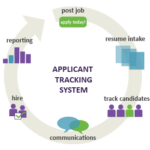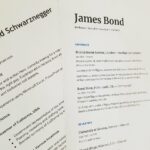
Typical resume mistakes of designers
Most of an advertising agency’s employees, of course, are managers, but the key product is creativity. Therefore, job seekers for the designer positions and copywriters often seek to show their creativity already in the resume or motivation letter. But, it is essential not to go over the top here.
Even in such a creative field as an advertising agency, a resume is a document where an HR specialist can quickly understand and evaluate the most important thing: work experience and achievements. The logic for presenting this information should be simple and clear.
Yes, creative positions involve an original presentation of yourself, trying to stay away from templates. But the main thing is not to overdo it.
Sometimes, in the desire to demonstrate their non-standard creative nature and attract the attention of an advertising agency recruiter, job seekers go too far and cause the opposite effect. The author of this article has collected the most common mistakes in responding to creative vacancies.
Resume as a poem
Many people think that writing a resume in verse is very original. This is a fairly common attempt to unleash your creative potential, especially among copywriters. Imagine the reaction of a recruiter who needs to quickly select a candidate for a copywriter job if he sees that out of 30 candidates 20 wrote their resume in verses.
Undoubtedly, a poetic skill can be useful in work, but it is still better to demonstrate it not in a resume or cover letter, but in a portfolio. Also, a resume in verses usually turns into a poem about yourself, your life, and a long creative path. The information that is important for a resume is often not there.
Anecdotes and humor
A sense of humor is undoubtedly a positive feature. And humor is often essential for creative professions. But the demonstration of this feature is best to be reserved for the interview. Resume jokes are not a great idea, same as poetry. The recruiter gets the impression that the applicant did not send the letter to an advertising agency, but a humorous TV show.
Embellishing reality
Putting the result of teamwork, where the applicant’s role was minimal on the list of personal achievements, is unacceptable. But this happens quite often between the applicants. There is also outright plagiarism when other people’s works are added to the portfolio.
Cheating always turns against the applicant. The world of creative professions is rather small, and it is usually not difficult to find out who the author is and what is the share of your participation in a particular project. Even if the recruiter did not find out before meeting with the applicant, at the first communication, it becomes clear that other people’s ideas were used as their own. Most importantly, if someone gets caught trying to cheat, this will remain a massive stain on their reputation. Indicate only your real experience.
No information on the results
Does your portfolio consist only of beautiful pictures if you are an artist or designer, or texts if you are a copywriter? This is not enough.
An ideal portfolio includes, in addition to the visual part (images and texts), a description of the concept that you have chosen to achieve specific goals and objectives. It is also important to indicate the results in numbers – for example, the number of unique views and readings, the number of clicks on the link with the picture, etc. Of course, only in the case that you are not prohibited from disclosing this data by a non-disclosure agreement.
To be simple, you need to show not just a picture or a text, but also the efficiency. And if there is no way to reflect this in the portfolio, then you need to be ready to explain how your creativity influenced the achievement of the project’s goals.
The incorrect way to submit a portfolio
It is essential in what way you show your portfolio, especially if these are heavy files with pictures or videos. Sending a link with zipped files for download is not the most inconvenient option for a recruiter.
It is better to use specialized online resources to place your portfolio so that it is convenient to view it. For example, Behance, dribble, and others, or create personal landing pages with your work and information about yourself.
Irrelevant response
The analysis of the huge number of responses received for the vacancy from candidates whose work experience and education absolutely do not meet the requirements specified in the job description is a frequent situation for all recruiters. But in the creative field, this problem is even more noticeable. Apparently, because creative work, most of all attracts those who are tired of their “non-creative” professions. To get a resume for the vacancy of an art director, which begins with the words: “I have been working as an accountant all my life, but I was born to create!” – Is quite usual.
But in the creative field, as in any other, professionalism is important for employers. If a vacancy describes specific requirements for experience and skills, a portfolio, then they are crucial for this work, and the agency will not consider applicants without them. If your goal is to gain experience, you’re better off considering starting positions or internships with agencies.
Bulk mailing
A typical story: an applicant sends a resume directly to the email of HR specialists from different agencies. At the same time, he does not bother himself with an individual letter to everyone. He sends one general letter so that all recipients can see the rest of the addressees, and “for fidelity” accompanies the resume with a message of approximately the following content:
“Hello!
My name is John. I hope that one of you will answer me. I am applying for the position of art director … ”
Needless to say, such action, quite obviously, demonstrates the attitude “I don’t care where to work”, and the sympathies of employers are on the side of those who carefully choose the company in which they would like to work. Write personally to the recruiter whose vacancy you are interested in – indicate, based on the requirements and responsibilities, your relevant experience, and why you are applying for this position.
Most likely, most of these mistakes are made by applicants for “creative” positions because they fear that the HR specialist will miss their response. But, if a vacancy is open at the agency, the recruiter’s task is to find a suitable candidate. This means that it is unlikely that he will ignore your letter for no reason. You don’t need “special effects” to grab attention – just a simple, well-structured resume with the right experience and a quality portfolio.
We can help you to avoid all those mistakes. Use our professional resume writing service today!

